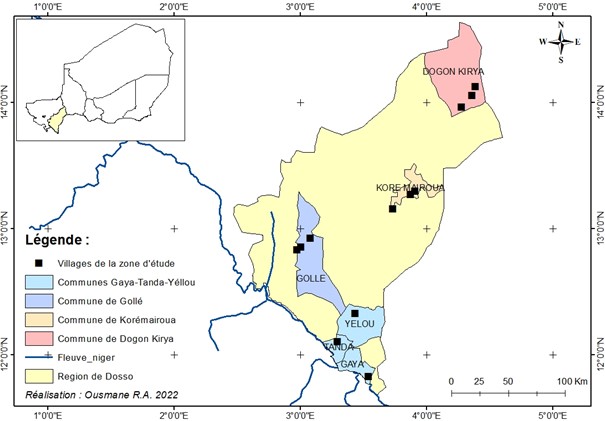Socio-Economic Values and Ecological Importance of Balanites aegyptiaca (L.) Del. in Sahelian Agrosystems in western Niger
Abstract
Balanites aegyptiaca contributes strongly to the resilience of Sahelian populations. All the organs of B. aegyptiaca are used either for food, medicinal purposes or for other services. However, very few studies on the socioeconomic importance of B. aegyptiaca have been conducted in Niger. The main objective of this study was to valorize the knowledge of the populations on the uses of B. aegyptiaca in the Sudan-Sahelian agrosystems of Niger. The study was conducted in the Dosso region. The region was chosen based on its two main agro-climatic zones, characterized by the scarcity of the species in the south and its abundance in the north. A survey was carried out in February 2021 to assess the diversity of uses. The findings revealed that the uses of B. aegyptiaca products are very diversified and varied considerably accross agro-ecological zones. The types of use varied significantly among ethnic groups. The Hausa possessed 88.26% of the use, the Zarma 14.47%, the Peulh 2.63%, the Songhai 1.32%, and Touareg 1.32%. All parts of B. aegyptiaca are used in traditional pharmacopoeia to threat various human and animal illnesses. 68.00% of respondents reported the interaction between Balanites and crops as very beneficial. B. aegyptiaca is prone to a variety of threats. Hence, 97.30% of respondents acknowledged the existence of several diseases and/or insect pests that affect Balanites' organs. Given the importance of this species in the region, more research is required to quantify its contribution to rural household food security and resilience.
References
Adamou, S. (2020). Socio-economic and ecosystemic impact of Balanites aegyptiaca (L.) Del. and the associated entomofauna in the agrosystems of southwestern Niger. Université Abdou Moumouni de Niamey, Niger. 97p.
Adamou, S., Amani, A., Mahamadou, M. H., & Dramé Yaye, A. (2020). Allometric model for the estimation of aerial carbon sequestered by Balanites aegyptiaca (L.) Del in the southwestern part of Niger. Afrique SCIENCE, 16(6), 188-203. http://www.afriquescience.net
Africajou (2016). Desert Date Oil. http://www.africajou.com/index.php/huiles-naturelles/huile-de-dattier-du-desert
Al-thobaiti, S. A., & Zeid, I. M. A. (2019). Antidiabetic potential of Balanites aegyptiaca kernel , flesh and their combination against streptozotocin-induced hyperglycemia in male rats. Tropical Journal of Pharmaceutical Research, 18(2), 263-271. https://doi.org/http://dx.doi.org/10.4314/tjpr.v18i2.7
Amadou, S. N. (2007). Capitalisation of Sahelian experience in biofuel: the case of Niger. AGRHYMET,Niamey, Niger.pp 1-35.
Avakoudjo, J., Kindomihou, V., Akponikpe, P. I., Thiombiano, A., & Sinsin, B. (2013). Plant species and restoration techniques for erosion zones (dongas) in Park W and its periphery in Karimama (North Benin). Journal of Applied Biosciences, 69, 5487-5495. https://doi.org/10.4314/jab.v69i0.95075
Barkat, N., & Sebrani, M. (2021). Production of biodiesel from the plant Balanites aegyptiaca. Master’s degree in Hydrocarbons and Renouvelable Energy from Ahmed Draïa Adrar University, Faculty of Science and Technology, Algeria.88p.
Boukar, A. M. (2014). Optimization of oil production from Balanites of Barsalogho. Master of Water and Environmental Engineering at the International Institute of Water and Environmental Engineering in Ouagadougou, Burkina Faso.50p.
Chambers, J. C. (2001). Pinus monophylla Establishment in an Expanding Pinus-Juniperus Woodland: Environmental Conditions, Facilitation and Interacting Factors. Journal of Vegetation Science, 12, 27-40.
Chevallier, M., Bensaid, S., Diallo, O., Sahki, R., Ganaba, S., Sanou, J., Bouguedoura, N., Vaillant, A., & Babin, D. (2003). Biodiversity and multidisciplinarity: methodology for drylands. Bois et Forêts des Tropiques, 276(2), 33-41.
CNEDD. (2009). Fourth National Report on the Biological Diversity of Niger.109p.
Creac'h, P. (1940). Balanites ægyptiaca. Its many applications in Chad. Revue de botanique appliquée et d'agriculture coloniale, 20, 578-593. https://doi.org/10.3406/jatba.1940.1576
CTA. (1994). Balanites, the champion tree of the Sahel. Spore 50. CTA, Wageningen, The Netherlands. https://cgspace.cgiar.org/handle/10568/60489
Dao, V. (1993). Contribution to the study of the use of Balanites aegyptiaca in the Sahelian zone: case of Sollé in the Yatenga. Ouagadougou. Master’s thesis, University of Ouagadougou, Burkina Faso. 86p.
Diallo, M. D., Goalbaye, T., Diop, L., Wade, T. I., Niang, K., Diop, A., & Guisse, A. (2016). Litterfall and decomposition of five woody species and their influence on grass biomass in the north ferlo zone of Senegal. Journal of Scientific Research of University of Lomé (Togo), 18(3), 1-18.
Doallo, M. D., Ndiaye, O., Diallo, A., Saleh, M. M., Bassene, C., Wood, S. A., & Diop, A. (2015). Influence of leaf litter of five tropical plant species on herbaceous floristic diversity in the Ferlo zone ( Senegal ). International Journal of Biological and Chemical Sciences, 9(2), 803-814. https://doi.org/http://dx.doi.org/10.4314/ijbcs.v9i2.20
Doamba, P. (2012). Impact of the use of wood and non-wood forest products on the management of the Arly National Park in Burkina Faso. International Institute for Water and Environmental Engineering (2iE). 58p.
Dramé Yaye, A., Adamou, S., Saminou, E. D. D., & Garba, M. (2021). Evaluation of the Entomological Fauna Associated with Balanites aegyptiaca (L.) Del. in South-west Niger. International Journal of Advanced Research, 9(1), 597-605. https://doi.org/10.21474/ijar01/12333
Habou, M. K. A., Rabiou, H., Abdou, L., Mamadou, I. M., & Mahamane, A. (2020). Ethnobotanical knowledge and socio-cultural importance of Balanites aegyptiaca (L.) Del. in Central-Eastern Niger. Afrique SCIENCE, 16(4), 239-252.
Harouna, N. D. A., Abou-Soufianou, S., & Boubacar, Y. (2019). Food insecurity of agricultural households and resilience strategies in the Sahel: The case of Goulbi Valley Maradi, Niger. European Scientific Journal, 15(18), 96-112. https://doi.org/10.19044/esj.2019.v15n18p96
Hiernaux, P. H. Y., Cissé, M. I., Diarra, L., & De Leeuw, P. N. (1994). Seasonal fluctuations in the foliage of Sahelian trees and bushes. Consequences for the quantification of fodder resources. Revue d'élevage et de médecine vétérinaire des pays tropicaux, 47(1), 117-125. https://doi.org/10.19182/remvt.9123
Jahan, N., Khatoon, R., Ahmad, S., & Shahzad, A. (2013). Antibacterial activity of medicinal plant Balanites aegyptiaca Del. and its in raised calli against resistant organisms especially those harbouring Bla genes. Journal of Medicinal Plants Research, 7(25), 1692-1698.
Kaboré-Zoungrana, C., Diarra, B., Adandedjan, C., & Savadogo, S. (2008). Nutritive value of Balanites aegyptiaca as feed for ruminants. Livestock Research for Rural Development, 20(4), 16.
Kamel, M. S., Ohtani, K., Kurokawa, T., Assaf, M. H., El-Shanawany, M. A., & Ali, A. A. (1991). Studies on Balanites aegyptiaca fruits: An antidiabetic Egyptian folk medicine. Chemical & Pharmaceutical Bulletin, 31, 1229-1233.
Kimba, A. (2014). Balanite oil from the Zabéry of Téra union. Réseau National des Chambres d'Agriculture du Niger, 39, 1-3.
Kipkore, W., Wanjohi, B., Rono, H., & Kigen, G. (2014). A study of the medicinal plants used by the Marakwet Community in Kenya. Journal of Ethnobiology and Ethnomedicine, 10(24), 35. https://doi.org/10.1186/1746-4269-10-24
Kirikoshi, H. (2017). Economic differentiation and safeguard against hunger in southern Niger of sahel region: Agro-landscape and multi-purpose tree use of hausa farmers. Japanese Journal of Human Geography, 69(1), 43-56. https://doi.org/10.4200/jjhg.69.01_043
Klorane (2012). The Desert Date Palm and the Great Green Wall. Sources of life in the Sahel. 21p.
Lacasetik. (2020). Precious beauty oils "Adoua" from Niger. https://www.lacasetik.fr/beauté-naturelle-solidaire-et-durable-d-afrique/huile-de-beauté-précieuse-de-balanites-adouwa-du-niger
Liu, H. W., & Nakanis, K. (1982). The structures of balanitins, potent molluscicides isolated from Balanifes aegyptiaca. Tetrahedron, 38(4), 513-519.
Lopez-Pintor, A., Espigares, T., Benayas, J. M. R., & Sal, A. G. (2000). Effects of Simulated Parent-Created Microenvironmental Conditions on Germination of Retama sphaerocarpa (L.) Bios. Seeds. Journal of Mediterranean Ecology, 1, 219-226.
Mohamed, A. M., Wolf, D., & Spiess, W. E. (2000). Recovery and characterization of Balanites aegyptiaca Del. Kernel proteins: Effect of defatting, air classification, wet sieving and aqueous ethanol treatment on solubility, digestibility, amino acid composition and sapogenin content. Nahrung, 44(1), 7-12.
Mohamed, A. M., Wolf, W., & Spiess, W. E. (2002). Physical, morphological and chemical characteristics, oil recovery and fatty acid composition of Balanites aegyptiaca Del. Kernels. Plant Foods for Human Nutrition, 57, 179-189.
Ndoye, M., Diallo, I., & Gassama-Dia, Y. K. (2004). Reproductive biology in Balanites aegyptiaca (L.) Del. a semi-arid forest tree. African Journal of Biotechnology, 3(1), 40-46.
Oléo-Sine (2016). Oléo-Sine: Fair Trade Production in the Sine Valley, Senegal. https://www.oleosine.com/index.php/produit/huile-de-dattier-du-desert-bio-pro
Sagna, M. B., Diallo, A., Sarr, P. S., Ndiaye, O., Goffner, D., & Guisse, A. (2014). Biochemical composition and nutritional value of Balanites aegyptiaca (L.) Del fruit pulps from Northern Ferlo in Senegal. African Journal of Biotechnology, 13(2), 336-342. https://doi.org/10.5897/ajb2013.12395
Sereme, A., Millogo-Rasodimby, J., Guinko, S., & Nacro, M. (2008). Therapeutic Power of tannins producing species of Burkina Faso. African Pharmacopoeia and Traditional Medicine, 15(1), 41-49.
Tahar, M. B. (2008). Impact of the zone of influence of 3 woody species (Faidherbia albida, Balanites aegyptiaca and Azadirachta indica) on soil fertility and millet production. Master’s thesis, Université Abdou Moumouni, Agroforestery Department of the Faculty of Agronomy in Niamey, Niger. 44p.
Tchiagam, J. B. N., Ndzié, J.-P., Bellefontaine, R., & Mapongmetsem, P.-M. (2011). Vegetative propagation of Balanites aegyptiaca (L.) Del., Diospyros mespiliformis Hochst. ex. A. Rich. and Sclerocarya birrea (A. Rich.) Hochst. in northern Cameroon. Fruits, 66(5), 327-341. https://doi.org/10.1051/fruits/2011047
Tiétiambou, R. S. F., Bazongo, P., Kouyaté, M. A., & Lykke, A. M. (2015). Production of Balanites aegyptiaca oil. https://www.researchgate.net/publication/297259967_Production_de_l'oil_of_Balanites_aegyptiaca
Zida, W. A. (2009). Study of the regeneration of Balanites aegyptiaca (L.) Del, Sclerocarya berrea (A. Rich.) Hochst. and Diospyros mespiliformis Hochst. ex A. Rich. Rich. in the northern Sudanian zone of Burkina Faso. Diploma of Engineering of the Polytechnic University, Institute of Rural Development of Bobo-Dioulasso, Burkina Faso. 101p.


This work is licensed under a Creative Commons Attribution 4.0 International License.
Copyright for this article is retained by the author(s), with first publication rights granted to the journal.
This is an open-access article distributed under the terms and conditions of the Creative Commons Attribution license (http://creativecommons.org/licenses/by/4.0/).








1.png)














